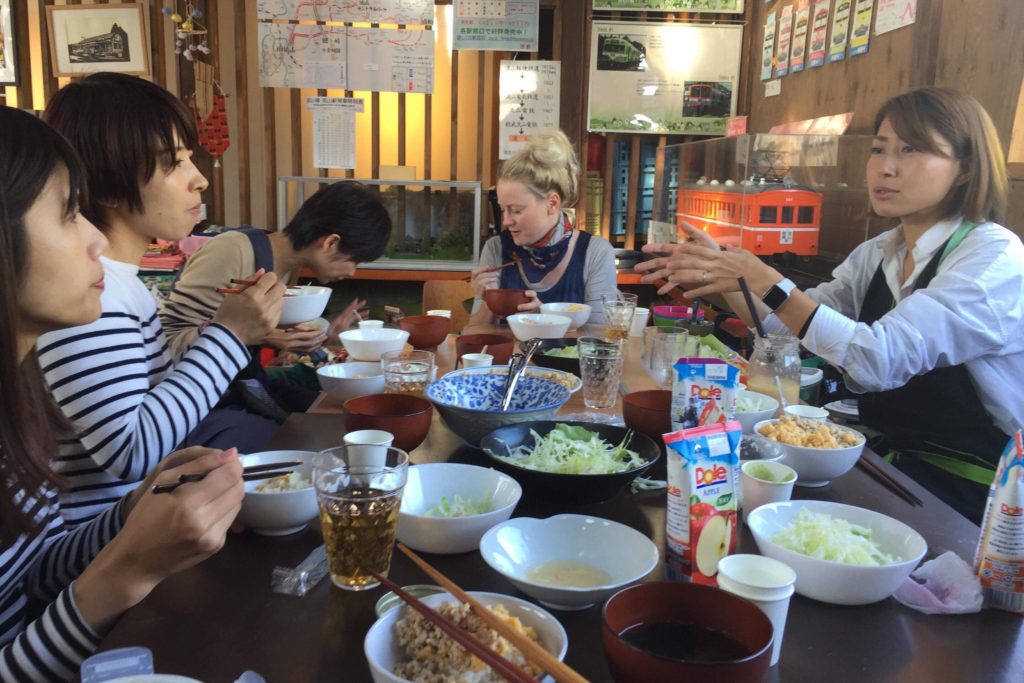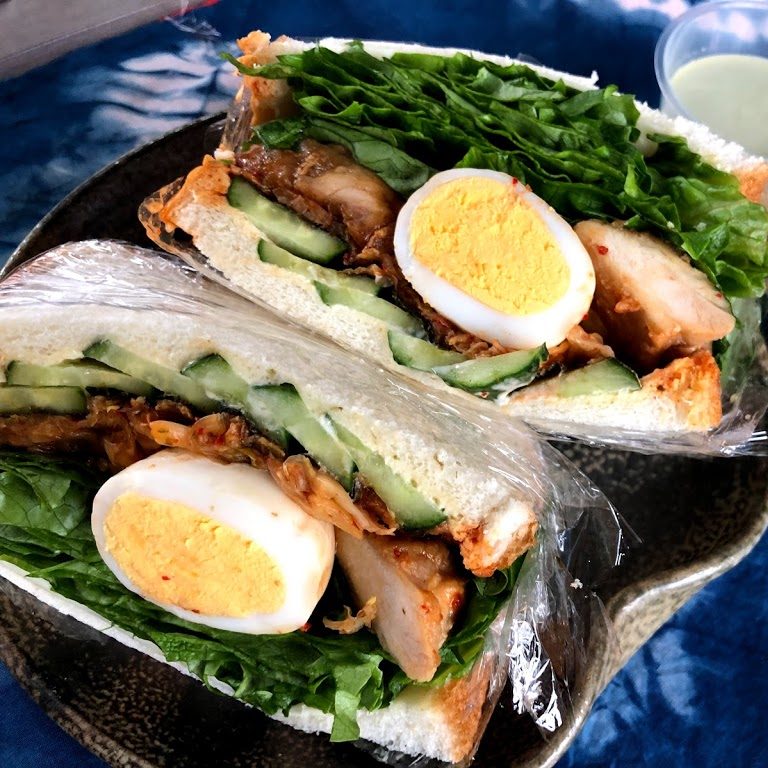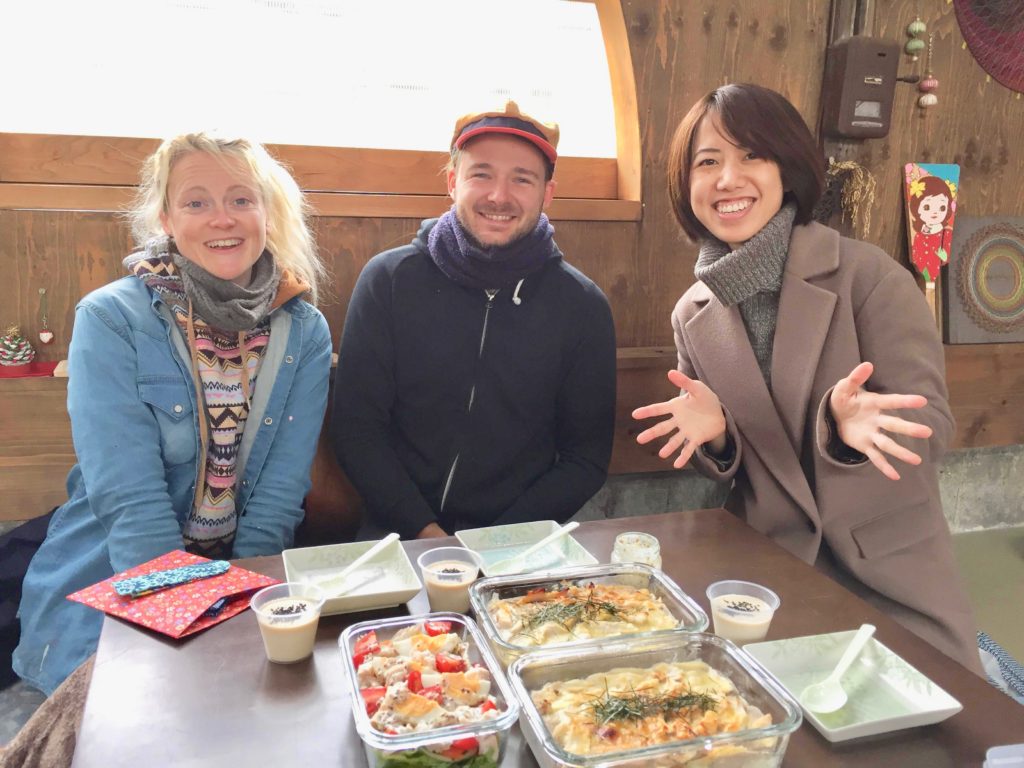2019年10月〜12月の約2ヶ月間で、本みりん研究所を運営するmachiminが実施した「流鉄壁画プロジェクト」。そこで、みりん研究員の佐藤や黒田が、英・壁画ペイントアーティストClare Wallis(クレア・ウォーレス)さんに流山の白みりんを使った食事を作り、ランチの時間を共に過ごしました。
▼その時の様子はこちら
約2ヶ月間のプロジェクトは無事大成功に終わりましたが、クレアさんがこの食事を通して得た気付きや感想をまとめてくださいましたのでご紹介します。
ごはんを通じて知った日本(Japan That I Saw Through Meals by Clare Wallis)
流山にあるmachiminで過ごした日々から2ヶ月ほどが経とうとしている。今、毎日ご馳走になった食事を思い出し、振り返ってみるとみんなで囲んだ食事はコミュニテイーでの活動を盛り上げるだけではなく、豊かで素晴らしく発展した和食を教えてくれたように思います。
It is nearing two months since our time at machimin, Nagareyama.
Looking back and remembering the food we got each day, it not only allowed the work within the community to prosper but graciously displayed the rich splendours of this highly developed Japanese cuisine.

machiminでの食事は自発的に地元住民の方々が作ってくれ、どの方もそれぞれに伝統のある和食の知識を持ち、それを教えてくれるために手を挙げてくれたのでした。
These meals were made voluntarily by locals from within the community.
People had stepped forward who prided themselves on having special knowledge in areas within this traditional cuisine.
発酵の知識を豊富に持つ女性たちは、味噌や甘酒を作る工程を細かく教えてくれました。こういう基礎を知ることで、和食の根本にある味わいを理解できるんだなと思いました。
A few ladies were fermentation experts and knew a lot about the processes involved in making miso and Amazake. Understanding the principles of these helped form a better understanding of -in my opinion- the fundamentals in Japanese flavours.
麹や大豆、みりんについてたくさん知り、この三つを使った様々な組み合わせが和食のベースにあり、味をうまく支えていることがわかりました。
I learnt about Koji, Soya and Mirin. Different combinations of these 3 elements form the delicious bases that hold the building blocks of Nippon flavour.


「和食」と一言で言っても幅広い味や作り方があり、ここではできる限り書き留めたいと思いますが、私は料理評論家やシェフなわけじゃないので適切な表現ができないかもしれません。以下の文章では特に印象に残ったものをまとめてみました。
There was such a wide variety of flavours and processes, I will do my best to write about them here, I am not a food critic or chief so my dialogue may not be appropriate at times but below is a sample of the moments that stood out to me.
machiminでの食事は普段皆さんが食べているような日常の料理からハレの日の特別な料理まで、色々な料理をいただきました。テーブルの上でも色々な料理の工程、焼いたり、炒めたり、茹でたりを見ることができて、皆さんトングや菜箸、しゃもじを手に手伝っていました。
I was introduced to simple meals of the everyday to grander meals for celebrations and special events.
The variety of interaction within the eating process ranged from griddling, frying and boiling on the table whilst people helped themselves with tongs, skewers or ladles.
たこ焼きを作る工程は特に魅力的で、細かく刻んだ具をパラパラと専用の鉄板に流し込んだ生地の上にちりばめる様子はまるで、農家さんが種を蒔いている姿みたい。その後に華麗な棒さばきで、あっという間に生地がまんまるの球体になっていきます。ネギ、天かす、たまにキムチ。あっ、あと紅生姜!このピンクのものは、甘くてピリッとして本当に美味しい。漬物の中で一番のお気に入りです。たこ焼きにも他の料理にも彩りと食感をプラスしてくれる。焼きそばにもカレーにも、もちろん世界で一番美味しい日本の炊きたてのお米にも紅生姜はバッチリ。
Takoyaki (balls of batter filled with octopus) have a charm to watch made in front of you with all the varying ingredients chopped so finely and scattered into the designated frying holes, like a farmer sowing seeds, followed by frantic stick action to make the batter turn into balls. Green onions, tempura scraps, sometimes kimchi, and Pickled ginger! The pink strands of sweet sharp joys. My favourite of all the pickles, these spice up the balls and any dish with a flash of colour and bite. Fried noodles, curry, and let’s not forget the sticky rice, the best rice in the world.
日本のお米は本当に美味しくて、machiminでいただいたお米を育てている方に会えたのにも感激しました。machimin初日に振る舞われたおにぎりは今まで見た中で一番大きくてびっくり。中身は梅干し、ツナ、たらこがぎっしり詰まっていて、とても温かく歓迎されているように感じました。
It was such an honour to be shared the rice and meet the farmer who actually grew it. The first day we were given Onigiri, big rice balls wrapped in seaweed. The biggest I have seen to date, packed with sour plum, tuna, fish eggs, such a generous and hearty welcome, bursting with gratitude.


毎食、メインのおかずとは別に小鉢や漬物、汁物、カリカリする魚のなにか、海苔などをつけてくれて、美しく切られた果物は、細い爪楊枝にちょっと刺して食べる。その一つ一つに真心を感じました。
Each meal was adorned with a number of tiny side dishes, pickles, soups, crispy fishy crunchy bits, seaweed sheets and of course a beautiful cut slice of fruit at the end, eaten off the end of a tiny stick.
サンドイッチは溢れるほど具が入っていて、名前は忘れてしまったけど、チキンカツや卵、ピクルスの入った「ギルティーサンドイッチ」はボリュームも美味しさも感動的でした。あと、鉄板で焼いて醤油とお酢をつけて食べる餃子は私のお気に入り。
Sandwiches were made that overflowed with the middle bit (the best bit) I can’t quite remember but I think it was called ‘the guilty sandwich’ due to its generous helpings of katsu chicken, egg and pickles.
Gyosas griddled and turned with tongs, soya and vinegar dipping sauce a favourite of mine.


手巻き寿司の時にはお刺身が美しく並べてあり、色鮮やかで、キャンディー屋さんでなにを買おうか迷ってしまう子どものように目移りしてしまいました。ピンクやオレンジ色のキラキラしたお刺身をちょっと塩気のあるご飯と海苔で巻く。こんなに美しいく楽しい食べ物だから、お誕生日や特別な日に食べるというのもうなずけます。なんだかメキシコのタコスを思い出しながら、好きなものでいっぱいになった手巻き寿司をほおばりました。
Hand rolls, where beautiful sashimi was cut and laid out in a glorious spread of colours for each to choose from like children in a candy shop. I can see why the hand roll (Te Maki-sushi) is for birthdays and special occasions, it is a spectacular sight full of pinks and oranges glinting ready to be wrapped in a delicious salty seaweed sheet. It reminded me of Mexican tacos and the choices laid out to fill our hand with as pleased.
シンプルに具をお出汁で煮たおでんは、洗練されていて温かく、体の隅々まで沁み渡る。日本では子どもにも人気で、コンビニや持ち帰りできるお店も多いみたい。贅沢なスープの中に不思議な具が浮いていて、具はそれぞれユニークな食感でした。色々な大きさや形をした魚の練り物。しらたきは口の中でボヨンボヨン飛び跳ねているみたいだった。大きなお餅が入った巾着は、ビヨーンと良く伸びる。大きめに切ってある大根は出汁をたくさん吸っていて、出汁を口まで運んでくれる。おでんを始め、鍋物は冬、残った食材を余すことなく食べるので一般的なんだそう。
The simpler meals such as Odeng and the quick boil broths were wholesome and elegant in the warm, nourishment they provided. They were a favourite of children and you could get them in most convenient stores as a fast food takeout. Intriguing objects bobbed about in this rich soup, each with its own unique texture. Fish sausages of different shapes and sizes, Konjac jelly Noodles that gave your teeth a bouncy castle. Large mochi rice sacks full of stretchy gloop. Giant pieces of radish submerged brimming with juices, a great way of storing the broth’s flavour allowing the meaty liquid to surge into your mouth. These broths are common in the winter and a sustainable way of continuing leftovers from previous meals.


ここまで毎食毎食、丁寧に料理をして、美しく盛り付けるような国は日本しかないと自信を持って言えます。どの料理も細部にまで気を配っていて、大根や人参を切って作った可愛らしい飾りが付いていることまで。
I can confidently say I believe no other country produces such a consistent and effortless mastery of food presentation. Every meal presented was carefully considered including extra details like characters carved into radishes or shapes cut out of carrots.
流し込まずに、少しずつ色々なものを食べて味わう。一口一口の価値を噛みしめているような、そんな感じ。
The small portions of each tasty bite brings extra value that this is something to savour mindfully and not just gobble down.
ガエタンは日本で食べた料理について、「ちょうど良い量で味のバランスがとても良かった。初めての味も食感も多くて、驚きや発見もいっぱい。味わいは豊かで濃厚なのに食後、体が重たいと感じることもないのが不思議。甘いのとしょっぱいのが一緒になっている料理が多いのにもびっくりした。」と言っていました。甘い卵焼きや梅干しなど、不思議なのにとても美味しいものばかりでした。
Gaetan said ‘The food had good proportion and a nice balanced of flavours. Many flavours were surprising and new textures were involved. He never felt too heavy after a meal even though they were rich and flavourful. It was unusual to eat sweet and salty together so often.’ Sweet omelette, sour plums, mixed up his usual interpretation of what dimension a food normally takes.


味わいと食感の絶妙なバランスについて、私は知らないことがたくさんありました。和食には芸術的な上品さがあって、特に深い知識はないけれど瞑想に似て、「思考に気づく」ということに気づくという行為に似ていると思いました。無理やり考えるのではなく、羽でなでるように軽やかにいろいろなことを考えさせてくれ、盛り付けや配膳にも上品で深い知性が感じられると思う。お皿の置く位置や分量、バランス、食べる順番まで考えてくれているの?と思うくらい、細部に意味や伝統を自然な感じで表現していて、とても興味深いです。
There is still so much I do not know as to how the subtleties of balance within flavours and textures are realised. There is a grace to the art of Japanese food that I can liken to my limited knowledge of a meditation approach, ‘noting’ the act of noticing a thought. Instead of clamping down on it and pushing the thought aside, one notes it with the lightness of a delicate feather’s touch.
There is something about the way many meals are presented that has an elegance and wisdom deeply rooted. Something to do with the positioning of the dishes, the balance of the proportions and perhaps the order they are eaten in? The meaning or tradition behind these efforts I am curious to understand or failing that at least learn about.
machiminは私の憧れていた日本の豊かさや品性、文化を、食を通じて見せてくれました。本当に、本当にありがとうございました。
machimin supplied a wealth of culinary elegance which provided me with an insight into a culture I truly admire.
Thank you machimin.



流山市のまちづくり会社(株)WaCreation代表、machiminオーナー。取り組みの一つとして、みりんの魅力を伝えるプロジェクトを立ち上げる。研究員の活動の場づくりとして菓子製造所をつくり、日々企画・営業にむかう二児の母。





